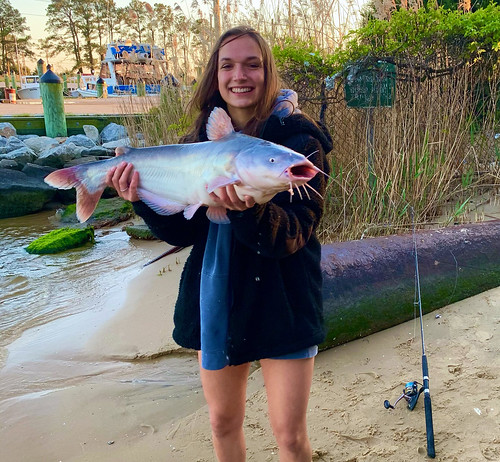Join the Hunt: How to Catch a Blue Catfish in Maryland

Angler Melissa Blair caught a 32-inch blue catfish at Kent Narrows Bridge in April 2021. Photo by Tristan Bapst
The bad news: Blue catfish can be easily found in a majority of Maryland’s rivers, both tidal and non-tidal and out in the Bay itself, and they eat almost anything.
The good news: Blue catfish can be easily found in a majority of Maryland’s rivers, both tidal and non-tidal and in the Bay itself, and they eat almost anything.
For anglers, blue catfish have become an attractive target because they are challenging to catch, but not elusive. They can be fished with light tackle from shore or on a boat. They can be found easily and are attracted to a variety of bait.
There is no offseason and no creel limit for blue catfish or any invasive species. It’s also a species with a long-standing state record catch – since 2012 – that’s just waiting to be broken. As an added bonus, they are highly regarded as table fare.
Blue catfish were first introduced in Virginia in the 1970s to create a new sport fishery. In some American river systems, the blue catfish is just another fish. Native to the river basins of the Mississippi, Missouri, Ohio, and Rio Grande, blue catfish share these waters with a range of other species. Those who brought them east made a critical error, believing they were a freshwater species only and would stay contained by the salty boundaries of the Chesapeake Bay watershed. It was quickly discovered that blue catfish are capable of living in both fresh and brackish water – and it wasn’t long before they traversed the Chesapeake watershed into new territory.
Where can I find blue catfish?
According to Keith Lockwood, Maryland Department of Natural Resources fisheries biologist and author of the weekly Maryland Fishing Report, blue catfish can now be found to some degree in every tidal river feeding into the Chesapeake Bay.
Lockwood notes there are an increasing number of charter boats offering fishing trips for blue catfish. The DNR website provides a list of fishing charter boats, anglers can ask if they have blue catfish trips.
“Sharing the charter fee with five of your fishing buddies makes this a very affordable trip with plenty of action and delicious filets to take home,” Lockwood said. “As an added bonus, there is no catch limit.”
Experts agree on the locations and tactics ideal for catching these fish. Blue catfish are typically found where the water is brackish, says Captain Marcus Wilson of Hot Licks Charters.
“In March and April, when the water is still cool, they tend to be on the edges of channels, coming out of the deeper waters,” Wilson said. “As the waters warm, they eventually get up to the flatter areas where it’s shallow.”
A fair portion of blue catfish tend to move downriver during the summer and move upriver in the spring and usually are found along channel edges. During the winter, blue catfish tend to seek out deeper waters in the channels of the tidal rivers’ middle to upper sections. They will often stack up in holes and channel sections where they will hold through the winter months. If fishing from a small boat, a depth finder can be very helpful to find these areas – they tend to run adjacent to high banks and the outside curves of the river. These are good things to keep in mind when fishing from the riverbanks.
There are plenty of large blue catfish in the upper Bay, all the way south to the Bay Bridge. The Susquehanna River in the Havre de Grace area and the deep hole just below the railroad bridge is a popular location. The lower Susquehanna, Middle River, Magothy and Chester rivers are all excellent places to fish for blue catfish.

Zack Minnick was fishing below Great Falls on the Potomac River in 2021 and managed to land this whopper of a blue catfish. Photo by Zack Minnick
Several rivers with large populations include the tidal Potomac, Patuxent, and Susquehanna rivers, along with the Choptank, Nanticoke, and Wicomico rivers. On the tidal Potomac, the waters below the Wilson Bridge are good places to fish during the winter.
In the Patuxent River, the area at and above the Benedict Bridge tends to be one of the better areas to fish for them. The Jug Bay area of the Patuxent River is another hot spot.The area near the Sharptown and Marshyhope Creek area on the Nanticoke River is another excellent place to fish for blue catfish. The Dover Bridge to the Denton area on the Choptank River and the Sharpstown area on the Nanticoke River are excellent places to fish for blue catfish. In the Wicomico River, below Salisbury is a good location.
The department features blue catfish hotspots each week in the Maryland Fishing Report, and also on a dedicated webpage.
What do I need to fish for blue cats?
Catfish like fresh cut bait from most any kind of fish. Common baits include menhaden, gizzard shad, white perch, bluegill sunfish, eel, or a selection from the fish market. Wild shrimp works as does chicken liver. Anglers seeking out the largest blue catfish of 60 pounds or more often use live bait. There is a prepared dough-like bait usually made with blood, cheese, and other stinky stuff and is placed on a treble hook, often with a spring-like device around the hook to hold the bait in place.
Chumming with ground fish can work wonders when fishing for blue catfish, especially from a boat, Lockwood said. Ground menhaden is easily purchased, and it is a good oily fish to use to attract catfish. A metal chum pot weighted to rest on the bottom is one of the best ways to develop a chum slick to attract blue catfish to an anchored boat.
Catfish have a very well-developed lateral line which helps them detect movement, their barbels also help detect smell. Any kind of extra added oil or scents also make the fish curious, Wilson adds.
“Chumming definitely attracts them,” Wilson said.
All catfish are fished on bottom rigs with hooks in the 1/0 size range; anglers should avoid small hooks because catfish have large mouths and tend to swallow them. Snelled hooks can make rigging easier. Usually a sinker of 1 to half-ounce size is good, and if the current is strong, a pyramid-style sinker can be a good choice to hold the rig to the bottom of the water body.
Sunfish, minnows and white perch are all good choices to bait the hook Nightcrawlers and chicken liver are also good.
Those who have been targeting blue catfish for some time agree that a slit 2-inch cork float helps keep the bait slightly off the bottom, Lockwood said. Many blue catfish anglers also believe in some type of rattle that is rigged ahead of the circle hook to help attract catfish. A barrel swivel is usually placed about 24 inches or so from the float and circle hook as a stop for the sliding sinker. The length of the leader can be adjusted, depending on the current, a shorter leader for swift current.
Sliding sinkers or fish-finder rigs are needed when fishing with circle hooks. When fishing from a boat, egg sinkers are commonly used. If fishing from shore, a bank or pyramid sinker may be needed to hold bottom in river currents. When fishing from a boat, conventional reels placed on free spool with the clicker on works well by allowing the catfish to move off with the bait and hook itself in the corner of the mouth when the reel is engaged. Spinning reels are popular when one must cast from shore and a bait runner type reel can be a real asset.
“We put the weight about two feet ahead of the bait, so if (the catfish) picks it up, the line will slide up the weight,” Wilson said. “He won’t feel the tension, he won’t spit it out or drop it when he knows something is up.”
One note of caution upon landing any kind of catfish – they have spines on three of their fins, so anglers should be careful when handling. Most importantly, do not return a blue catfish to the water alive. Another piece of equipment to have is a large enough cooler to carry the blue cats.
I caught a blue catfish! Now what?
The Maryland Department of Natural Resources urges anglers to kill all invasive species they catch; due to the damage they cause, blue catfish should not be caught and released back into the water.
Anglers who catch invasive species in Maryland waters have several options to make use of the fish – eat them, freeze them for future use as cut bait, fertilize your garden with them. However they are used, one less blue catfish in Maryland waters is always a good thing!


 1-888-373-7888
1-888-373-7888 233733
233733